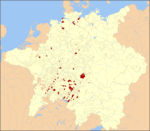Weißenburg in Bayern
Weißenburg in Bayern | |
|---|---|
 The old town hall of Weißenburg is one of the icons of the city | |
Location of Weißenburg in Bayern within Weißenburg-Gunzenhausen district  | |
Ortsteile | |
| Government | |
| • Lord mayor (2020–26) | Jürgen Schröppel[1] (SPD) |
| Area | |
| • Total | 97.55 km2 (37.66 sq mi) |
| Elevation | 422 m (1,385 ft) |
| Population (2022-12-31)[2] | |
| • Total | 18,854 |
| • Density | 190/km2 (500/sq mi) |
| Time zone | UTC+01:00 (CET) |
| • Summer (DST) | UTC+02:00 (CEST) |
| Postal codes | 91781 |
| Dialling codes | 09141 |
| Vehicle registration | WUG |
| Website | www.weissenburg.de |
Imperial City of Weißenburg im Nordgau Reichsstadt Weißenburg im Mediatised to Bavaria | 1803 | ||||||||
|---|---|---|---|---|---|---|---|---|---|
| |||||||||
Weißenburg in Bayern, formerly also Weißenburg im
Geography
Location
Weißenburg is located in central
Subdivision
The municipality is divided into 27 Ortsteile: the main town and the 26 villages of Dettenheim, Emetzheim, Gänswirtshaus, Haardt, Hagenbuch, Hammermühle, Hattenhof, Häuser am Wülzburger Berg, Heuberg, Holzingen, Kattenhochstatt, Kehl, Laubenthal, Markhof, Niederhofen, Oberhochstatt, Potschmühle, Rohrwalk, Rothenstein (Weißenburg), Schleifer am Berg, Schmalwiesen, Stadelhof, Suffersheim, Weimersheim, Weißenhof and Wülzburg.
History
Early history



The history of Weißenburg is generally traced back to the
The city became a
Modern history
Weißenburg lost its independence in 1802 and became part of the Bavarian kingdom in 1806. It was however saved from insignificance with the construction of a railway between Nuremberg and Augsburg which goes through the city and which supported industrialisation. Following World War II over 6,000 refugees and people expelled from the territories which Germany lost settled in the city and have since played an important role in its industry and culture.
The many stages in the history of Weißenburg can still be seen today. There are many ruins from the Roman times. One of the finest is the remains of a Roman bath which was excavated in 1977 and has been turned into a museum. The city wall from the Middle Ages has survived almost intact with its towers and in the Gothic Town Hall the city's elected members have held their meetings from 1476.
Sights
- The Ellinger Tor is the most famous City gate of Weißenburg.
- The Bismarck tower is a memorial to the first German chancellor Otto von Bismarck.
- The Castra Birciana is a former Roman military camp.
Wülzburg
During
Climate
| Climate data for Weißenburg in Bayern (1991–2020 normals) | |||||||||||||
|---|---|---|---|---|---|---|---|---|---|---|---|---|---|
| Month | Jan | Feb | Mar | Apr | May | Jun | Jul | Aug | Sep | Oct | Nov | Dec | Year |
| Mean daily maximum °C (°F) | 3.1 (37.6) |
5.0 (41.0) |
9.8 (49.6) |
15.1 (59.2) |
19.4 (66.9) |
22.9 (73.2) |
24.9 (76.8) |
24.8 (76.6) |
19.7 (67.5) |
13.9 (57.0) |
7.5 (45.5) |
3.8 (38.8) |
14.2 (57.6) |
| Daily mean °C (°F) | 0.3 (32.5) |
1.1 (34.0) |
4.9 (40.8) |
9.4 (48.9) |
13.8 (56.8) |
17.2 (63.0) |
19.0 (66.2) |
18.7 (65.7) |
14.0 (57.2) |
9.4 (48.9) |
4.5 (40.1) |
1.3 (34.3) |
9.5 (49.1) |
| Mean daily minimum °C (°F) | −2.5 (27.5) |
−2.4 (27.7) |
0.4 (32.7) |
3.5 (38.3) |
7.8 (46.0) |
11.2 (52.2) |
13.0 (55.4) |
12.8 (55.0) |
8.9 (48.0) |
5.5 (41.9) |
1.7 (35.1) |
−1.2 (29.8) |
4.9 (40.8) |
| Average precipitation mm (inches) | 44.3 (1.74) |
37.3 (1.47) |
44.5 (1.75) |
38.1 (1.50) |
69.0 (2.72) |
75.9 (2.99) |
83.9 (3.30) |
71.7 (2.82) |
49.2 (1.94) |
51.3 (2.02) |
48.8 (1.92) |
52.5 (2.07) |
666.5 (26.24) |
| Average precipitation days (≥ 1.0 mm) | 15.9 | 13.5 | 14.5 | 12.5 | 14.0 | 14.5 | 15.1 | 13.7 | 12.7 | 14.3 | 14.2 | 17.0 | 171.9 |
| Average snowy days (≥ 1.0 cm) | 10.6 | 9.8 | 3.7 | 0.4 | 0 | 0 | 0 | 0 | 0 | 0 | 2.1 | 8.0 | 34.6 |
| Average relative humidity (%)
|
83.0 | 79.1 | 73.6 | 66.5 | 67.7 | 68.5 | 67.6 | 69.2 | 75.4 | 81.7 | 85.6 | 85.3 | 75.3 |
| Mean monthly sunshine hours | 57.2 | 85.7 | 135.2 | 188.5 | 219.4 | 229.1 | 239.6 | 228.2 | 165.9 | 109.9 | 54.0 | 45.4 | 1,749 |
| Source: World Meteorological Organization[3] | |||||||||||||
Notable people
- Gustav Ritter von Kahr (1862–1934), politician
- Hans Hofmann (1880–1966), painter
- Rudolf Nebel (1894–1978), rocket pioneer and engineer
- Markus Steinhöfer (born 1986), footballer
References
- Bayerisches Landesamt für Statistik, 15 July 2021.
- ^ Genesis Online-Datenbank des Bayerischen Landesamtes für Statistik Tabelle 12411-003r Fortschreibung des Bevölkerungsstandes: Gemeinden, Stichtag (Einwohnerzahlen auf Grundlage des Zensus 2011) (Hilfe dazu).
- ^ "World Meteorological Organization Climate Normals for 1991–2020". World Meteorological Organization Climatological Standard Normals (1991–2020). National Oceanic and Atmospheric Administration. Archived from the original on 12 October 2023. Retrieved 13 October 2023.
External links
 Media related to Weißenburg in Bayern at Wikimedia Commons
Media related to Weißenburg in Bayern at Wikimedia Commons Weißenburg in Bayern travel guide from Wikivoyage
Weißenburg in Bayern travel guide from Wikivoyage- We Love Weißenburg (Facebook)



